Table of contents
- What is a Trust Wallet Private Key?
- Private Key vs Recovery Phrase on Trust Wallet
- How to Get Trust Wallet Private Key in 2024: Step-by-Step
- Step 1. Launch the Trust Wallet App or Browser Extension and Access Settings
- Step 2. Select the “Wallets” Option from the Menu (on the Mobile App) or “View Secret Phrase” (on the Browser Extension)
- Step 3. Click on the “Three-Dot” or “More Information” Icon Next to the Desired Wallet
- Step 4. Opt for Manual Backup
- Step 5. Copy Your Trust Wallet Recovery Phrase
- Step 6. Use the BIP39 Mnemonic Code Converter Tool on Your Browser or Download It
- Step 7. Input Your Recovery Phrase into the “BIP39 Mnemonic” Field and Select the Coin
- Step 8. Copy the Generated Private Key
- FAQ
Over time, many users have faced a common issue: losing access to their private keys due to forgotten passwords or misplaced hardware wallets.
According to Chainalysis, around 25% of bitcoins are thought to be forever inaccessible due to this. Interestingly, early investors and miners own about 70% of these bitcoins.
These insights are from a Chainalysis study conducted in 2018. Just picture how this percentage might have changed by now, at the end of 2023.
You might be familiar with stories of people losing their cryptocurrency fortunes due to forgotten passwords – we certainly are. One such tale involves Ames Howells, a 35-year-old who accidentally discarded a hard drive holding 7,500 bitcoins back in 2013 while cleaning his home.
If you’re reading this, we hope you haven’t faced this issue yourself; you’re likely here to prevent it. That’s exactly why, if you’re a Trust Wallet user, this article will guide you on how to get your Trust Wallet private key before it’s too late.
This way, you can avoid ending up in a situation similar to that of Ames Howells or others who have experienced such losses.
What is a Trust Wallet Private Key?
In the same manner as in the Trust Wallet recovery phrase case, just like when you create a crypto wallet, you’ll come across a moment where your wallet generates some codes. Now, we are talking about a code which is called a private key.
Wondering why? Well, when any wallet is made on the blockchain through facilitators like Trust Wallet, you’re given two keys – a public key and a private key.
Think of your wallet address as the public key. It’s like an open address that lets you send and receive digital transactions on the blockchain. But here’s the catch: if anyone can send transactions using this public key, how do you prove that the accepted cryptocurrency is really yours?
That’s where private keys come into play. They’re a bit like passwords that look like this: 5Kb8kLf9zgWQnogidDA76MzPL6TsZZY36hWXMssSzNydYXYB9KF.
They confirm that you own your digital assets, and they safeguard your money from being taken out of your account.
So, the Trust Wallet private key is a unique combination of letters and numbers created by your Trust Wallet. Each account gets its own Trust Wallet private key. This key is what lets you access the cryptocurrency stored in your account, so it’s crucial for keeping your crypto safe and sound.
Please note that private keys and recovery phrases differ, although they are often confused in crypto.
Private Key vs Recovery Phrase: What is the Difference Between a Private Key and a Recovery Phrase?
To provide a more straightforward summary and enhance your understanding of the contrasts between a private key and a recovery phrase, presented below is a compilation organized according to various criteria:
- Nature – While private keys are unique strings of characters, seed phrases are sequences of words, usually 12 to 24.
- Function – Private keys are used for ownership verification and transaction signing, while recovery phrases serve as a backup for wallet restoration.
- Access – Private keys grant access to individual wallet contents, whereas recovery phrases can restore an entire wallet and its contents.
- Security – Private keys need to be kept confidential and secure, while recovery phrases provide an added layer of security for wallet recovery.
- Generation – Private keys are typically generated through cryptography, whereas recovery phrases are generated following the BIP39 standard.
- Ease of Management – Private keys can become cumbersome when managing multiple wallets, whereas recovery phrases are often easier to manage than multiple private keys.
Private Key vs Recovery Phrase on Trust Wallet
Creating a wallet in Trust Wallet isn’t just for one type of money – it’s like having lots of crypto wallets for more than a thousand different digital currencies, all in one place. But keeping track of each wallet’s secret key could be a real hassle.
Trust Wallet and many other crypto wallets follow an industry rule to make things simpler and safer.
Instead of making you remember many secret keys (because let’s be serious, it’s not easy to memorize 5Kb8kLf9zgWQnogidDA76MzPL6TsZZY36hWXMssSN. And this private key is strictly for a single type of crypto. If you want both Bitcoin and Ethereum, you will have two private keys, and you will have to remember both); they give you a special 12-word phrase that’s easy to read and remember. This phrase acts like a master key that can unlock all your wallets together.
So, if you ever need to get back into any of your crypto wallets, just use this 12-word phrase, and it’ll help recreate the secret key for that wallet. It’s like having one key that opens many doors!
By utilizing this recovery phrase, you can access your private key.
How to Get Trust Wallet Private Key in 2024: Step-by-Step
Before delving into the process of obtaining your private key from Trust Wallet, it’s important to note that the steps we’re about to outline are applicable to both the Trust Wallet mobile application and the browser extension introduced in late 2022. This universality ensures that the steps are relevant to users regardless of their platform.
Additionally, as reiterated earlier, getting the private key necessitates familiarity with your recovery phrase and its location within the application.
Consequently, the initial stages will focus precisely on this aspect, paving the way for more comprehensive insights as we proceed.
Step 1. Launch the Trust Wallet App or Browser Extension and Access Settings
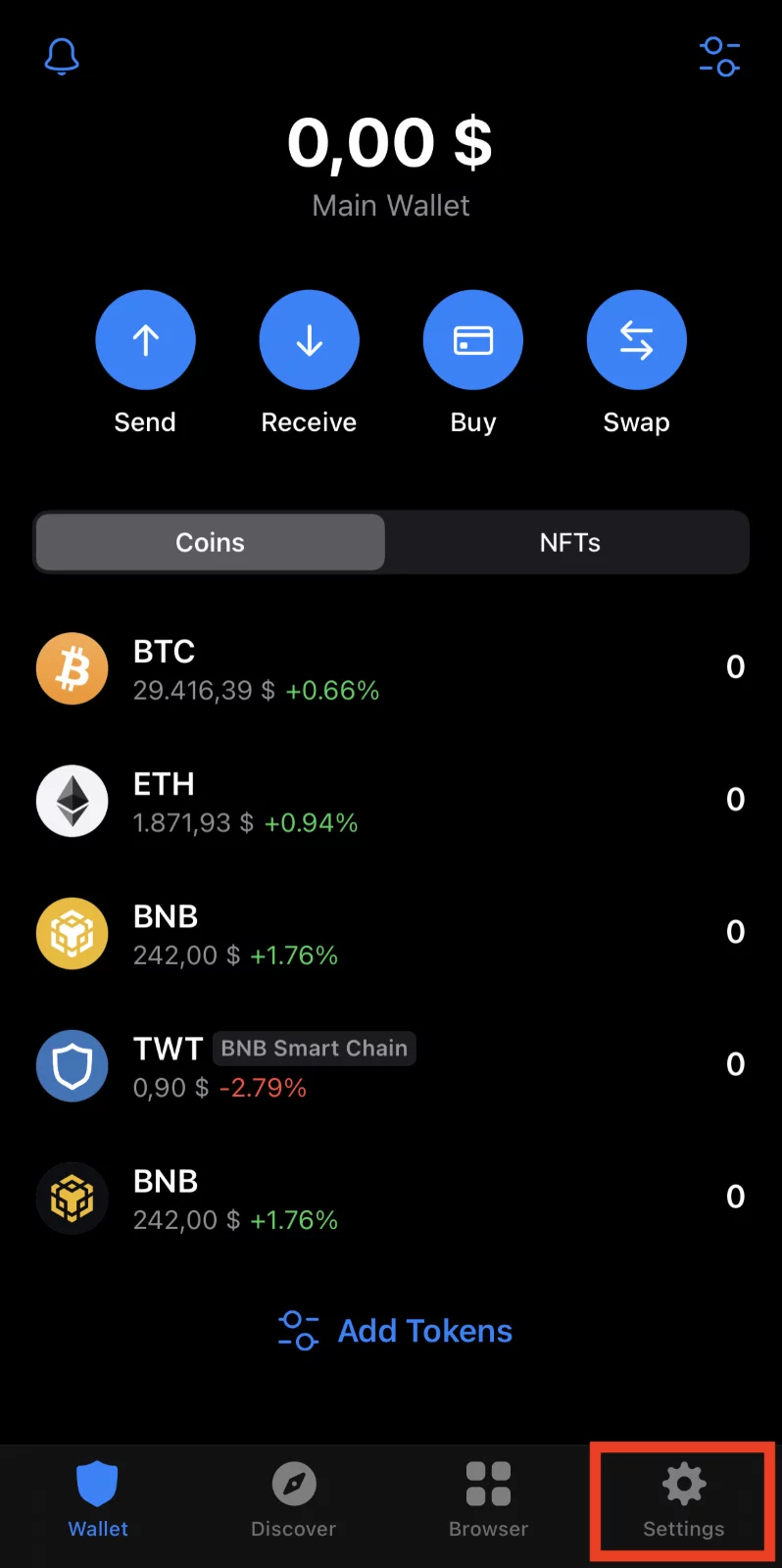

After you get your Trust Wallet, begin by opening the Trust Wallet application on your mobile device or your browser extension.
Once opened, locate and tap on the Settings icon, conveniently situated at the bottom-right corner of your screen.
Step 2. Select the “Wallets” Option from the Menu (on the Mobile App) or “View Secret Phrase” (on the Browser Extension)
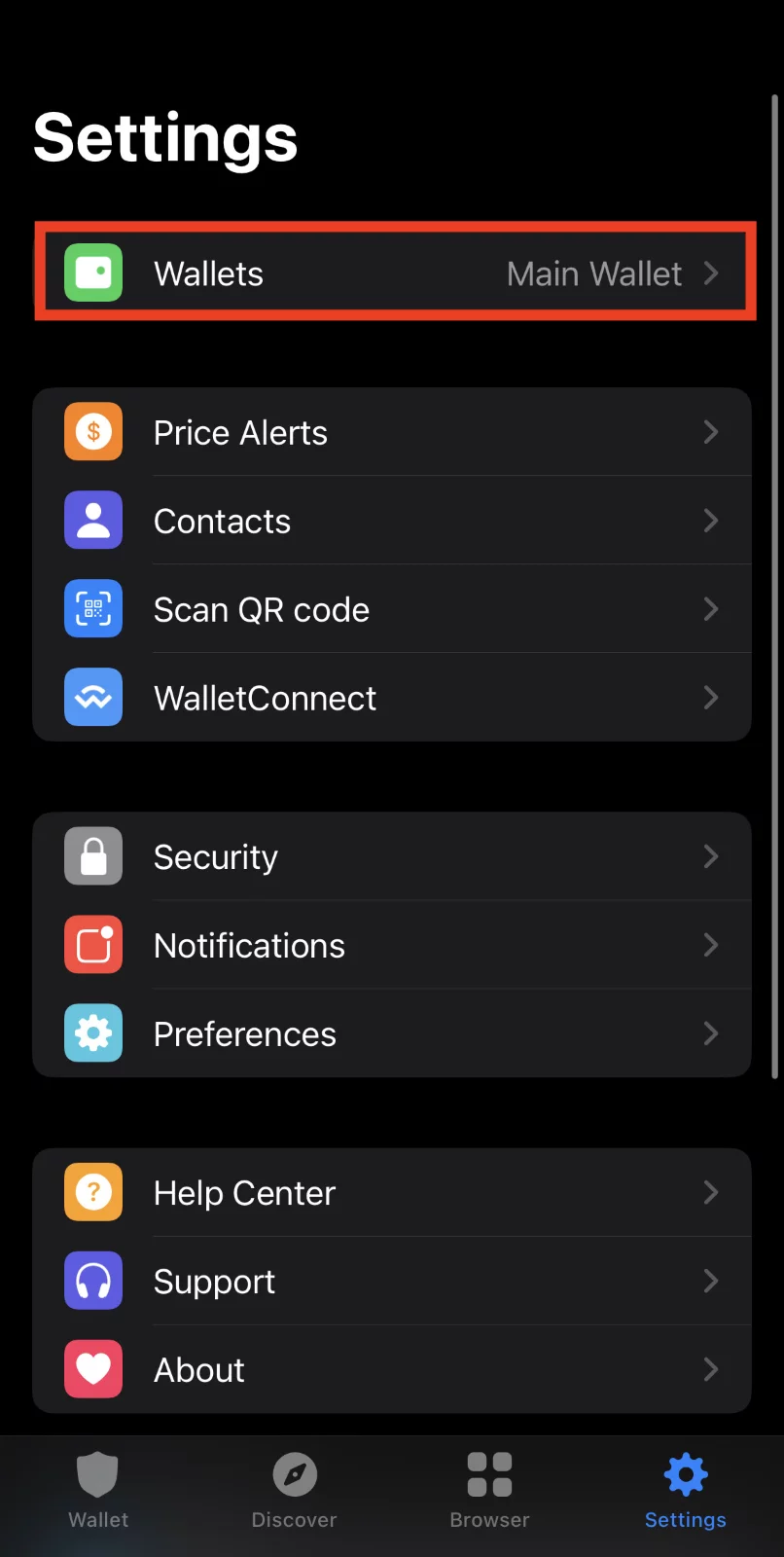
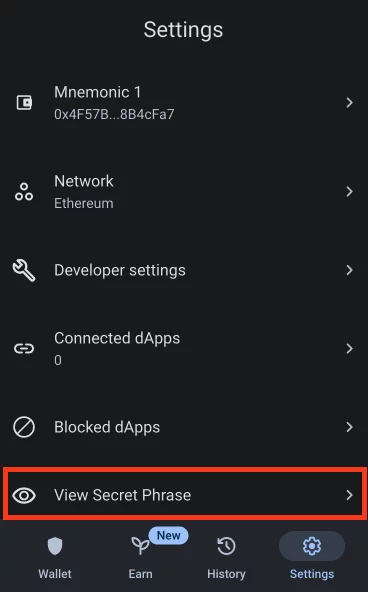
On the mobile app, within the Trust Wallet settings section, choose the “Wallets” option. This selection will lead you to a comprehensive display of the wallets associated with your account.
On the browser extension, within the Trust Wallet settings tab, you can already select “View Secret Phrase” (or “Show Secret Phrase”) to reveal the recovery phrase associated with your wallet. For the app users, continue with the following step.
Step 3. Click on the “Three-Dot” or “More Information” Icon Next to the Desired Wallet
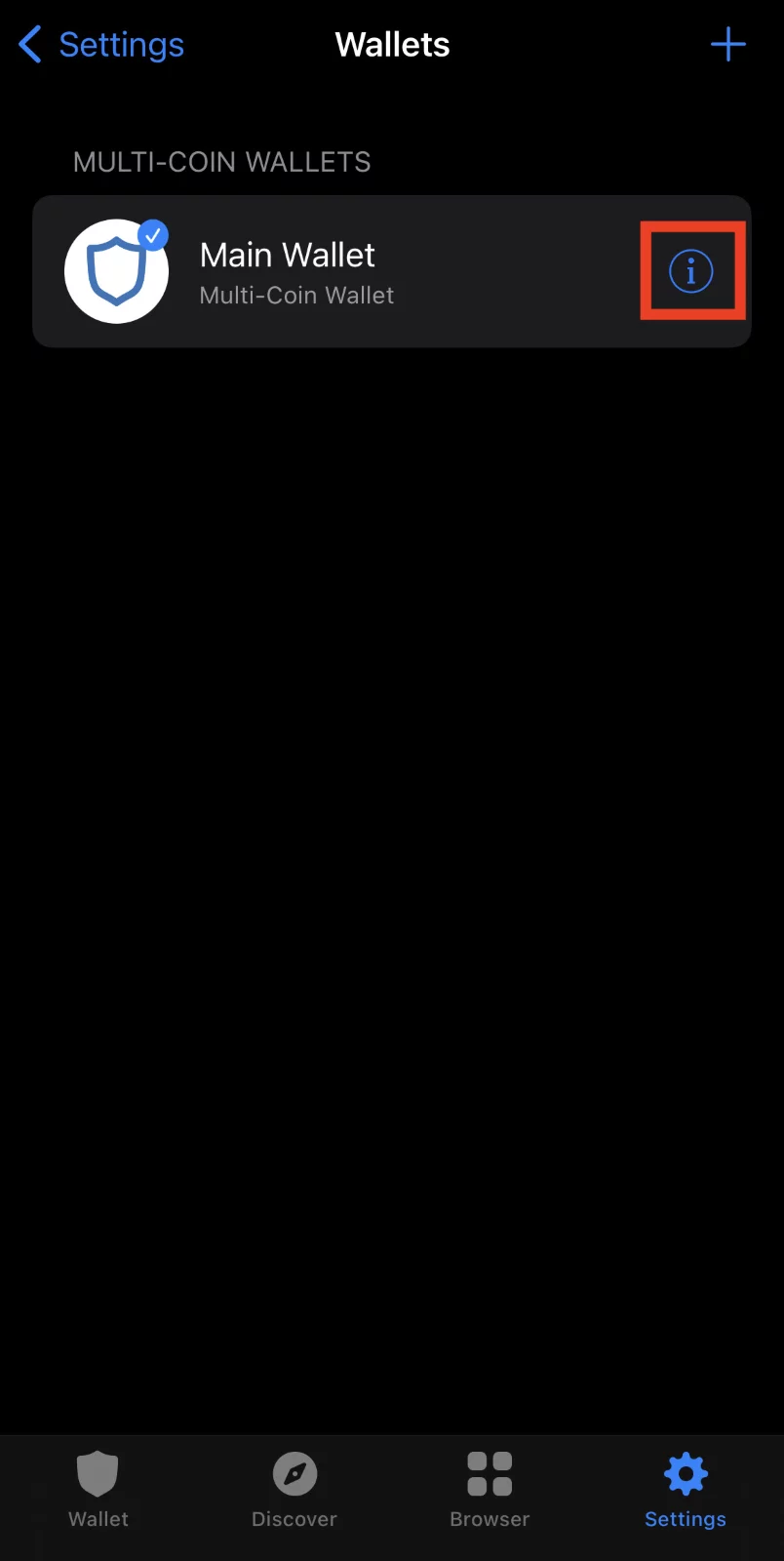
Upon entering the list of your wallets, click on the “three-dots” icon (for Android devices) or the “more information” icon (for iOS devices) positioned beside the specific wallet for which you intend to access the recovery phrase.
Step 4. Opt for Manual Backup
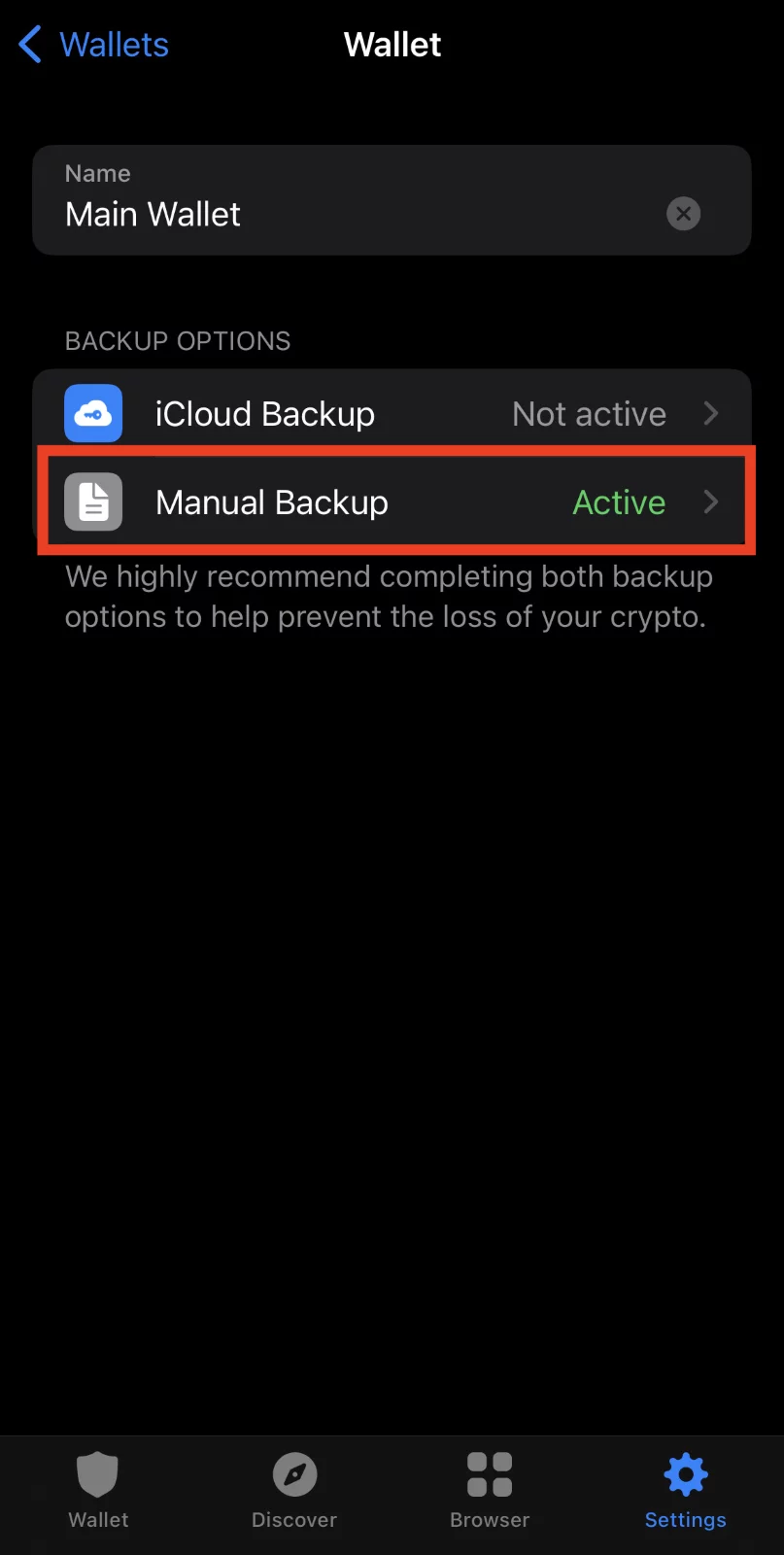
Following that, opt for the “Manual Backup” selection.
This action will lead you to a fresh page where you’ll be prompted to confirm your consent to reveal the recovery phrase. A conspicuous cautionary message will underscore its importance and emphasize the criticality of safeguarding it confidentially, with your knowledge alone.
Step 5. Copy Your Trust Wallet Recovery Phrase
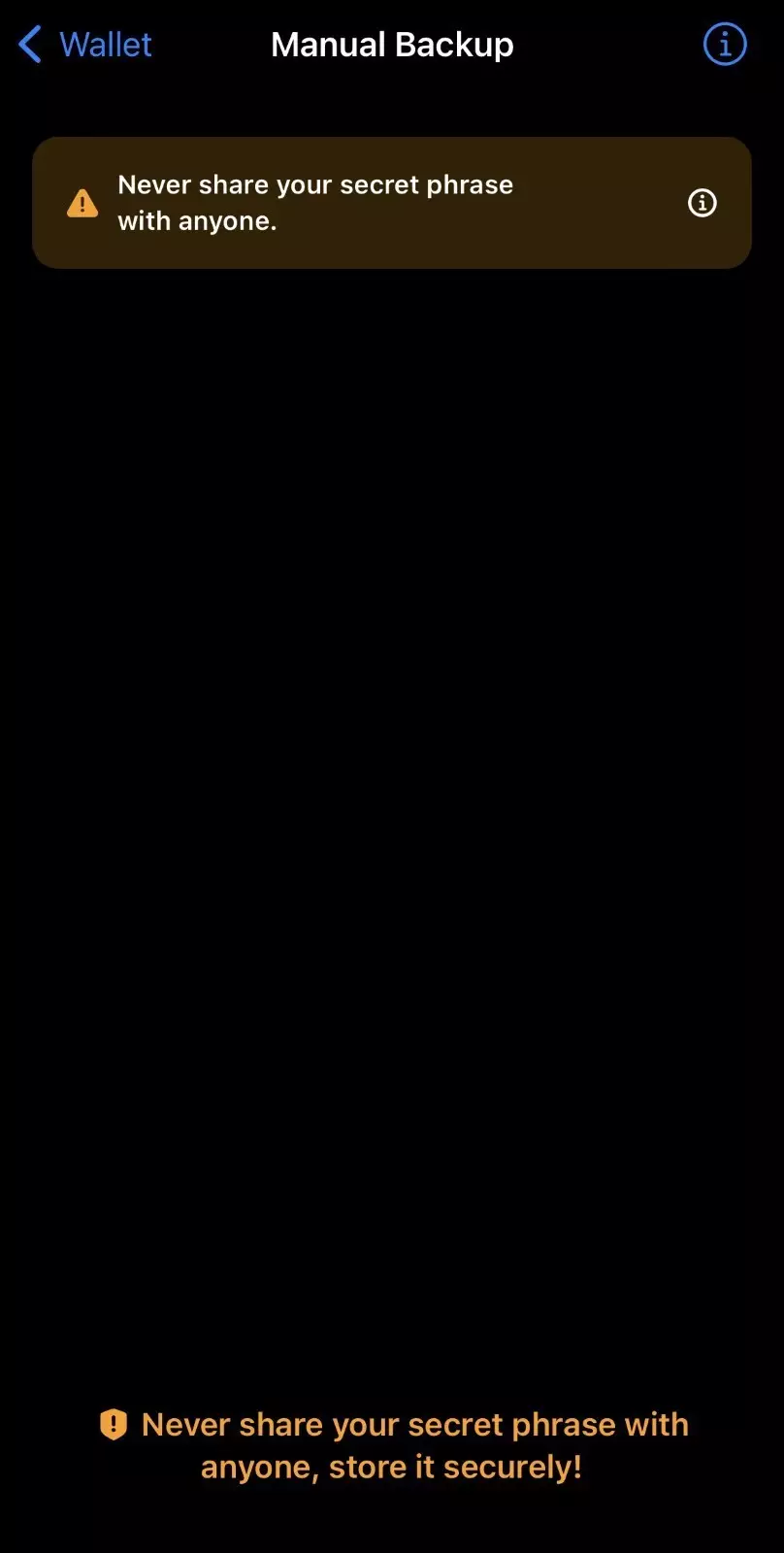

It will be unveiled within your wallet upon recognizing and agreeing to the potential risks connected to unveiling the recovery phrase. As soon as it becomes visible, make sure to promptly copy it and stow it away in a secure location accessible solely to you. Now, after you copy the recovery phrase, we can generate your private key.
Step 6. Use the BIP39 Mnemonic Code Converter Tool on Your Browser or Download It
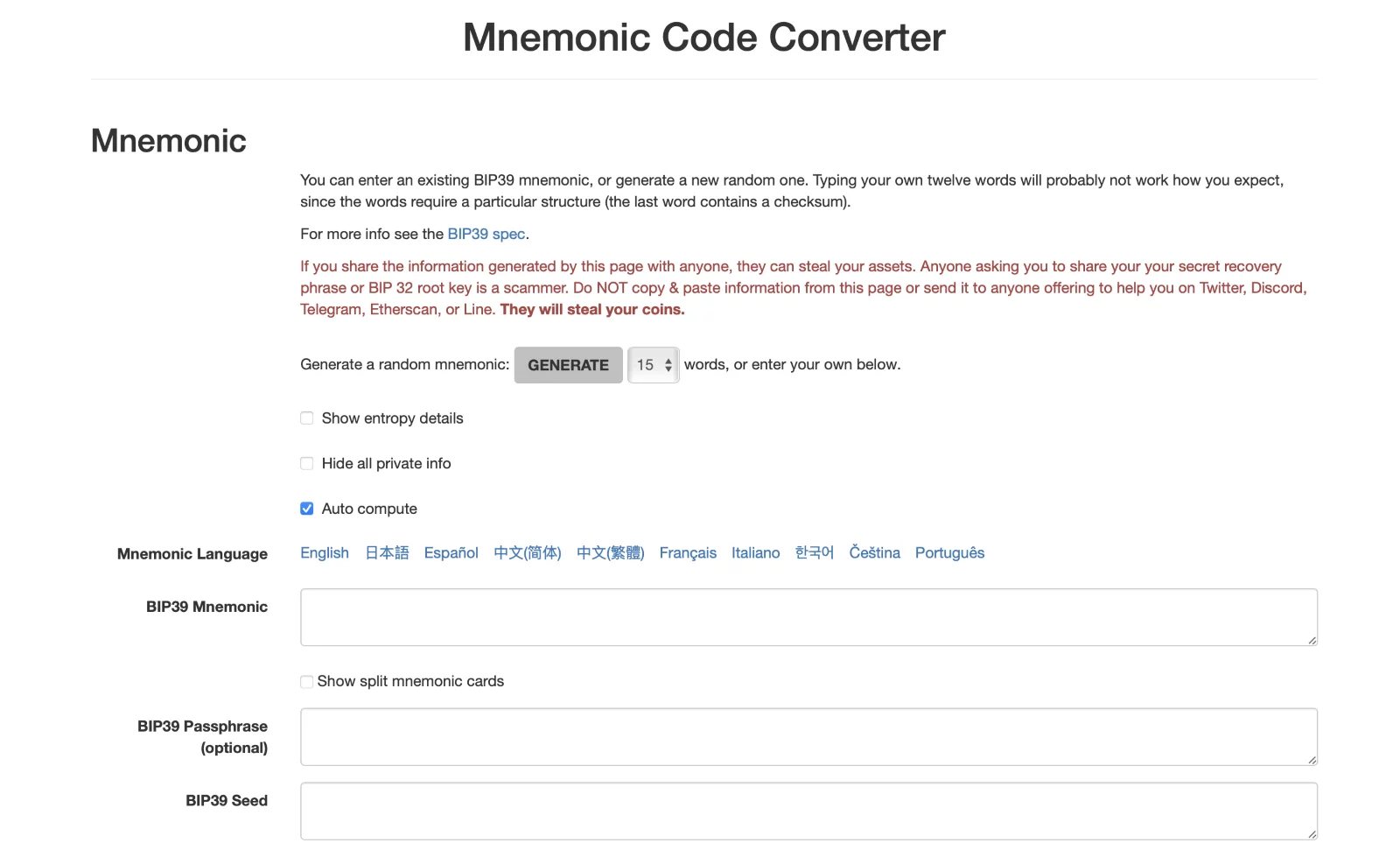
To create private keys for the wallets linked to your recovery phrase, you’ll need a special tool called the BIP39 Mnemonic Code Converter. You can access this tool directly through the website or by downloading it to use offline in your browser.
We strongly suggest downloading and running the tool on your device for added security. This minimizes the chances of anyone gaining access to your seed phrase.
Once the download is complete, open the HTML file in your browser. It’s recommended to use Google Chrome for this purpose.
Step 7. Input Your Recovery Phrase into the “BIP39 Mnemonic” Field and Select the Coin
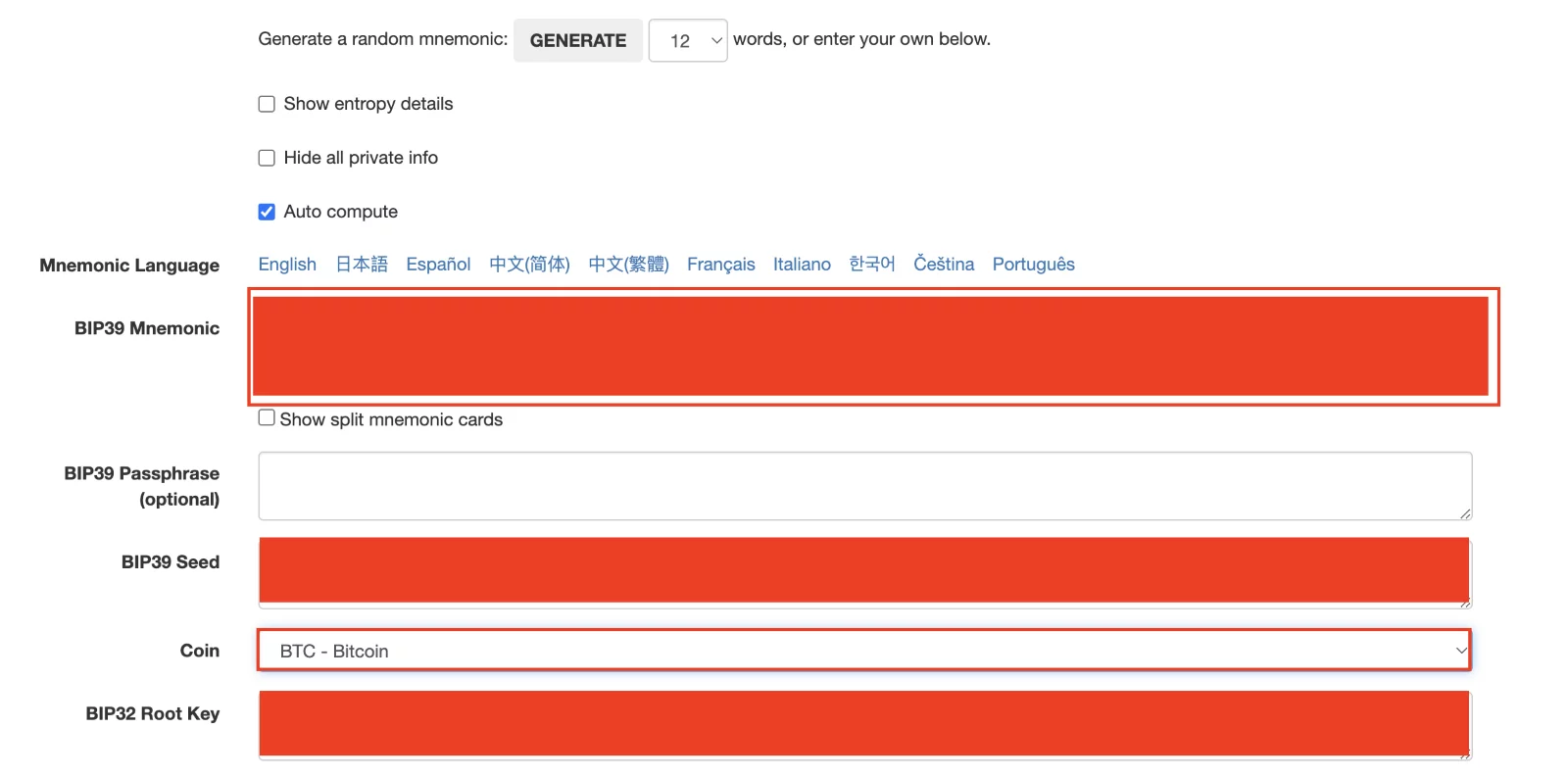
Once the tool is up and running, you must paste the recovery phrase you copied earlier from Trust Wallet (or your backup) into the designated “BIP39 Mnemonic” section.
Scroll down to the next section and pick the type of coin you want. For instance, if you’re looking for the private key of your Trust Wallet Bitcoin wallet, select Bitcoin, but if you’re looking for the one of your Ethereum wallet, choose Ethereum.
Step 8. Copy the Generated Private Key
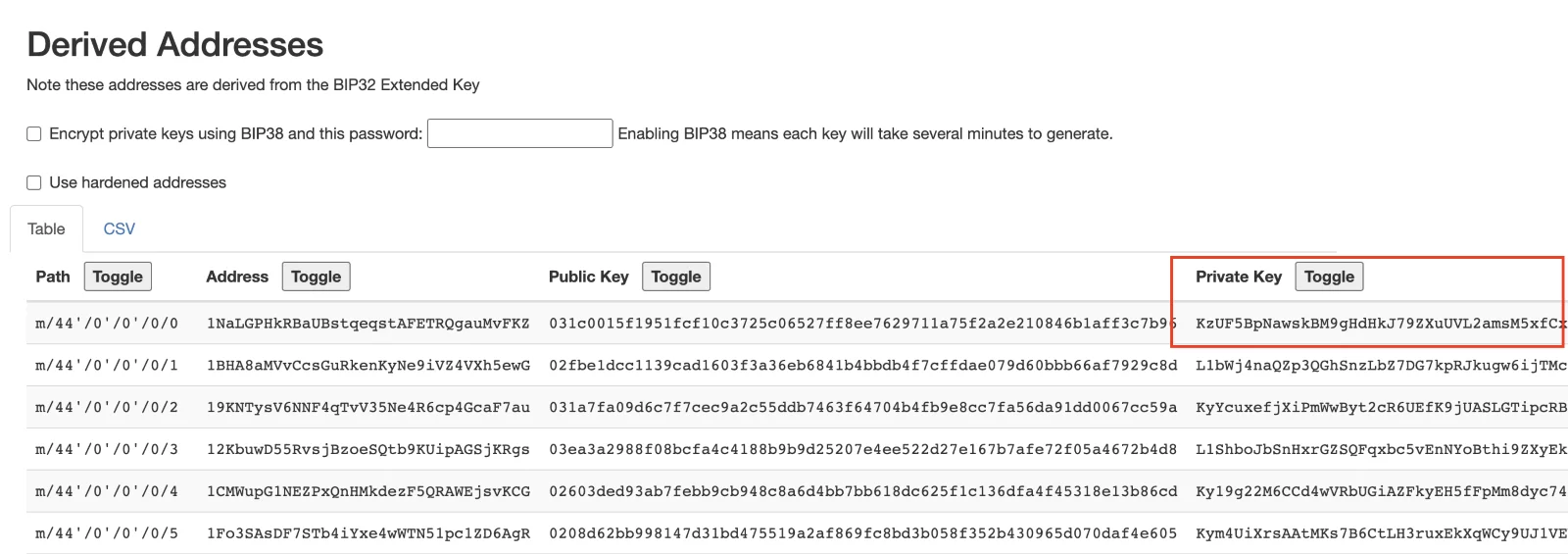
Continuing to the “Derived Addresses” section, copy the private key in the first row. This private key corresponds to the default or first wallet of the chosen coin within the recovery phrase.
By following these steps, you’ve successfully created the private key for your chosen asset using the recovery phrase.
You can repeat this process for all coins supported by Trust Wallet’s Mnemonic code converter tool.
Remember, it’s vital to back up these generated private keys securely. Access to the private key means full and unrestricted access to your wallet and all its stored funds.
FAQ
What is Trust Wallet?
Trust Wallet is a non-custodial crypto wallet that serves as a secure mobile app for managing various cryptocurrencies. Unlike hardware wallets, Trust Wallet operates directly on your smartphone, providing a user-friendly interface for controlling your digital assets and exploring decentralized applications.
What is a Trust Wallet Recovery Phrase?
A Trust Wallet recovery phrase is a unique sequence of words created by your cryptocurrency wallet during its initial setup.
These words are vital in unlocking your wallet when organized in a specific sequence. The recovery phrase is a mnemonic representation of all the private keys linked to your wallet.
Can I Change My Trust Wallet Private Key?
No, you cannot change your Trust Wallet private key. Once a private key is generated, it remains constant and cannot be altered.
If you have concerns about the security of your private key, it’s crucial to take extra measures to keep it safe and secure.
What Happens If I Forget My Trust Wallet Private Key?
Right now, recovering your private key isn’t possible, so it’s important not to forget your Trust Wallet private key.
However, you can still move your wallet address or take out your money and put it on another platform. This is why keeping your private key safe is important – to prevent any security problems.
Can I Import a Wallet to Trust Wallet Using a Private Key?
Yes, you can import a wallet to Trust Wallet using just a private key.
To import a wallet with a private key on Trust Wallet:
Open the Trust Wallet app or browser extension, go to Settings, and then select “Wallets.”
Tap the “+” button on the Wallets page and choose “I already have a wallet,” then “Restore with secret phrase.”
Now, select the specific cryptocurrency you want to import using the private key, tap “Private Key,” and paste your private key into the designated text box.
After that, tap “Import” to bring the wallet into your Trust Wallet account using the provided private key.
Can I Get the Private Key Using Only a Wallet Address?
Nope, it’s a no-go without the recovery phrase. If you don’t have it, there’s just no way to get hold of a private key.
Can I Open Multiple Accounts in Trust Wallet?
Yes, you can do that. Once you’ve set up the initial account, feel free to make additional wallets or a new wallet, and you can even craft a fresh profile on another device.
Conclusion
So, the persistent challenge of losing access to your crypto assets or cryptocurrency holdings due to forgotten passwords or misplaced hardware wallets remains a critical issue in the digital.
However, as the crypto landscape continues to evolve, taking preventative measures becomes increasingly crucial to prevent scenarios similar to those experienced by unfortunate individuals.
In earnest, we trust that your intention to seek out this article aligns with the desire to preempt any potential challenges rather than grapple with more problematic issues. Our foremost aspiration is that the information presented here is a beacon of guidance.
We hope our article has proven to be a valuable resource, imparting the knowledge necessary to get your TrustWallet private key promptly. By taking these steps, you can take proactive measures to circumvent undesired circumstances that could arise in the future.

